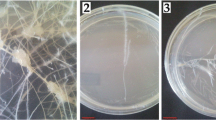Abstract
The screening of 37 Zea mays L. cultivars in nutrient solution using root elongation (24 h) as a parameter showed large genotypic differences in Al resistance among the genetic material evaluated.
Callose concentrations in root tips were closely and positively related to Al-induced inhibition of root elongation. Therefore, Al-induced callose formation in root tips appears to be an excellent indicator of Al injury and can be used as a selection criteria for Al sensitivity. In contrast, aluminium concentrations in root tips were not related to Al-induced inhibition of root elongation, nor to Al-induced callose formation. Callose formation was also induced by short-term A1 treatment in root tip protoplasts, and the response of protoplasts clearly reflected the cultivar-specific response to Al of intact roots. This indicates that in maize, Al sensitivity is expressed on the protoplast level.
Similar content being viewed by others
References
Ceballos H, Pandey S, Knapp E B and Duque J 1995 Progress from selection for tolerance to soil acidity in five tropical maize populations.InPlant-Soil lnteractions at Low pH. Eds. R A Date, NJ Grundon, GE Rayment and ME Probert. pp 419-424. Kluwer Academic Publishers, Dordrecht.
Delhaize E, Craig S, Beaton C D, Bennet R J, Jagadish V C and Randall P J 1993 Aluminium tolerance in wheat (Triticum aestivumL.) I. Uptake and distribution of aluminium in root apices. Plant Physiol. 103, 685-693.
Furlani P R and Furlani A M C 1991 Tolerância a aluminio e eficiência a fósforo em milho e arroz: características independentes. Bragantia, Carnpinas 50, 331-340.
Horst W J 1995 The role of the apoplast in aluminium toxicity and resistance of higher plants: a review. Z. Pflanzenernähr. Bodenkd. 158, 419-428.
Granados G, Pandey S and Ceballos H 1993 Response of selection for tolerance to acid soils in a tropical maize population. Crop Sci. 33, 936-940.
Köhle H, Jeblick W, Poten F, Blaschek Wand Kauss H1985 Chitosan elicited callose synthesis in soybean cells as a Ca2+-dependent process. Plant Physiol. 77, 544-551.
Lima M, Furlani P R and Miranda Filho de J B 1992 Divergent selection for aluminium tolerance in amaize (ZeamaysL.) population. Maydica 37, 123-132.
Llugany M, Massot N, Wissemeier A H, Poschenrieder Ch, Horst W J and Barceló J 1995 Aluminium tolerance of maize cultivars as assessed by callose production and root elongation. Z. Pflanzenernähr. Bodenkd. 157, 447-451.
Llugany M, Poschenrieder Ch and Barceló J 1994 Monitoring of aluminium-induced inhibition of root elongation in four maize cultivars differing in tolerance to aluminium and proton toxicity. Physiol. Plant. 93, 265-271.
Magnavaca R and Bahia Filho A F C 1993 Success in maize acid soil tolerance.InAdaptation of Plants to Soil Stress. Ed. J W Maranvill. pp 209-220. Intsormil Publ. No. 94-2. University of Nebraska, Lincoln.
Pandey S, Ceballos H, Magnavaca R, Bahia Filho A F C, Duque-Vargas J and Vinsco L E 1994 Genetics of tolerance to soil acidity in tropical maize. Crop Sci. 34, 1511-1514.
Pandey S, Ceballos H and Granados G 1995 Registration of four tropical maize populations with acid soil tolerance: SA-4, Sa-5, SA-6, and SA-7. Crop Sci. 35, 1230-1231.
Rincón M and Gonzales R A 1992 Aluminium partitioning in intact roots of aluminium-tolerant and aluminium-sensitive wheat (Triticum aestivumL.) cultivars. Plant Physiol. 99, 1021-1028.
Ryan P R, Ditomaso J M and Kochian L V 1993 Aluminium toxicity in roots: an investigation of spatial sensitivity and the role of the root cap. J. Exp. Bot 44, 437-446.
Schaeffer H J and Walton J D 1990 Aluminium ions induce oat protoplasts to produce an extracellular (1->3)β-D-glucan. Plant Physiol. 94, 13-19.
Scott B J and Fisher J A 1993 Comparing selection strategies for tolerance of acid soils.InAdaptation of Plants to Soil Stress. Ed. J W Maranville. pp 103-116. Intsormil Publ. No.94-2. University of Nebraska, Lincoln.
Staß A and Horst W J 1995 Effect of aluminium on membrane properties of soybean (Glycine max) cells in suspension culture. Plant Soil 171, 111-118.
Taylor G J 1995 Overcoming barriers to understanding the cellular basis of aluminium. Plant Soil 171, 89-103.
Wagatsuma T and Akiba R 1989 Low surface negativity of root protoplasts from aluminium-tolerant plant species. Soil Sci. Plant Nutr. 35, 443-452.
Wagatsuma T, Nakashima T and Tawaraya K 1991 Identification of aluminium-tolerant protoplasts in the original root protoplast population from several plant species differing in aluminium tolerance.InPlant-Soil Interactions at Low pH. Ed. R J Wright, V C Baligar and R P Murrmann. pp 789-793. Kluwer Academic Publishers, Dordrecht.
Wagatsuma T, Ishikawa S, Obata H, Tawaraya K and Katohda S 1995 Plasma membrane of younger and outer cells is the primary specific site for aluminium toxicity in roots. Plant Soil 171, 105- 112.
Wissemeier A H and Horst W J 1995 Effect of calcium supply on aluminium-induced callose formation, its distribution and persistence in roots of soybean (Glycine max(L.) merr.) J. Plant Physiol. 145, 470-476.
Wissemeier A H, Kotz F and Horst W J 1987 Aluminium induced callose synthesis in roots of soybean (Glycine maxL.) J. Plant Physiol. 129, 487-492.
Wissemeier A H, Diening A, Hergenröder A, Horst W J and Mix-Wagner G 1992 Callose formation as parameter for assessing genotypical plant tolerance of aluminium and manganese. Plant Soil 146, 67-75.
Zhang G, Hoddinott J and Taylor G J 1994 Characterization of 1,3 β-D-glucan (callose) synthesis in roots ofTriticum aestivumin response to aluminium toxicity. J. Plant Physiol. 144, 229-234.
Rights and permissions
About this article
Cite this article
Horst, W., Püschel, AK. & Schmohl, N. Induction of callose formation is a sensitive marker for genotypic aluminium sensitivity in maize. Plant and Soil 192, 23–30 (1997). https://doi.org/10.1023/A:1004204120863
Issue Date:
DOI: https://doi.org/10.1023/A:1004204120863




